Denmark ushered in a new era in global environmental policy with the introduction of the first tax on greenhouse gas emissions from the agricultural sector. This tax will require farmers to pay almost 100 euros per year for every cow and pig they own. The measure, the result of months of intense negotiations with trade associations and environmental groups, is seen as a fundamental step towards reducing greenhouse gas emissions.
This measure aims to reduce methane pollution by 70% by 2030, compared to 1990 levels.
The impact of agricultural emissions on the economy
Agricultural activities account for nearly a quarter of global greenhouse gas emissions, with livestock farming playing a significant role. According to the Joint Research Center of the European Commission, livestock farming contributes to 80% of emissions of ammonia into the air and nitrogen into water.
According to the United Nations Environment Programme, livestock farming is responsible for approximately 32% of human-caused methane emissions. Since 2020, methane levels in the atmosphere, including from landfills and oil and natural gas systems, have increased dramatically. Statistic Denmark reports that as of June 30, 2022, there were 1,484,377 cows in the Scandinavian country, with each cow producing an average of six tonnes of Co2 equivalent per year.
In particular, ruminants such as cows and sheep produce methane through their digestive systems, and nitrogen fertilizers used to feed them release additional greenhouse gases.
Methane is notoriously emitted by flatulence of cattle, which represent a significant source of pollution. Denmark intends to become the first country in the world to implement a specific tax on this type of emissions, with the ambitious goal of drastically cutting methane pollution.
Interestingly, livestock accounts for 11% of global emissions, with nearly two-thirds coming from cows.
How the new tax works
The Danish government has set an initial tax rate of 120 Danish kroner (16 euros) per tonne of carbon dioxide equivalent emissions, which will progressively increase to 750 kroner (100.5 euros) in 2035. With a 60% tax deduction , the initial effective cost will be reduced to 120 crowns, and will increase in subsequent years. The Danish parliament will have to vote to finally approve the tax by the end of the year, with broad support predicting certain approval.
From 2030, Danish farmers will have to pay 300 crownsand (about 40 euros) for every ton of carbon dioxide equivalent emitted. This amount is expected to grow to 750 crowns (around 100 euros) by 2035.
Market and state reactions to the Danish experiment
The new tax has sparked various reactions in the economic landscape. The Danish Society for Nature Conservation called it a “historical compromise“, seeing the measure as a solid basis for a future restructuring of the food industry by 2030. The Danish Prime Minister, Mette Frederiksen, hopes that this initiative can serve as a model for other countries, paving the way for similar measures at the international level.
Several governments are carefully watching this Danish experiment, hoping that it can provide an effective model for reducing agricultural emissions without compromising food security. Denmark’s combination of taxation and incentives aims to significantly reduce greenhouse gas emissions from livestock farming, while improving air quality.






